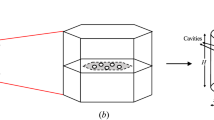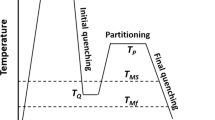Abstract
Research has been conducted about the hardness prediction for the carburizing and quenching process based on an optimized hardness simulation model, in accordance with the calculation rule of mixed phases. The coupling field model incorporates carburizing field analysis, temperature field analysis, phase transformation kinetics analysis and a modified hardness calculation model. In determination of the calculation model for hardness, calculation equations are given to be applied to low carbon content (x(C)≤0.5%) for the child phases and the martensite hardness is calculated for high carbon content (x(C)>0.5%) in alloy. Then, the complete carburizing-quenching hardness calculation model is built, and the hardness simulation data are corrected considering the influence of residual austenite (RA) on hardness. Hardness simulations of the carburizing and quenching process of 17CrNiMo6 samples have been performed using DEFORM-HT_V10.2 and MATLAB R2013a. Finally, a series of comparisons of simulation results and measured values show a good agreement between them, which validates the accuracy of the proposed mathematical model.
Similar content being viewed by others
References
CHEN Guo-min. Review on carburizing and hardening technology of gears in China [J]. Heat Treatment of Metals, 2008, 33(1): 25–33. (in Chinese)
NIU Shan-ting. Research on 3D finite element simulation and parameter optimization for quenching process [D]. Ji’nan: Shandong University. School of Materials Science & Engineering, 2007. (in Chinese)
MAYNIER P, DOLLET J. Hardenability concepts with applications to steels [M]. DOANE D V, KIRKALDY J S, eds. New York, USA: AIME, 1978: 518–544.
WOODARD P R, CHANDRASEKER S, YANG H T. Analysis of temperature and microstructure in the quenching of steel cylinders [J]. Metallurgical and Materials Transactions B, 1999, 30B: 815–822.
CARLONE P, PALAZZO G S, PASQUINO R. Finite element analysis of the steel quenching process: Temperature field and solid-solid phase change [J]. International Computers and Mathematics with Applications, 2010, 59: 585–594.
YUAN J, KANG J, RONG Y, SISSON R. FEM modeling of induction hardening processes in steel [J]. Journal of Materials Engineering and Performance, 2003, 12(5): 589–596.
KO D H, KO D C. Application of QFA coupled with CFD analysis to predict the hardness of T6 heat treated A16061 cylinder [J]. Journal of Mechanical Science and Technology, 2013, 27(9): 2839–2844.
WANG Ai-xiang, GAO Jin-zhu, Heat treatment of new type high alloy carburizing gear steel 17CrNiMo6 [J]. Heat Treatment of Metals, 2010, 35(10): 82–86. (in Chinese)
SMOLJAN B. Numerical simulation of steel quenching [J]. Journal of Materials Engineering and Performance, 2002, 11: 75–79.
SUGIANTO A, NARAZAKI M, KOGAWARA M. Numerical simulation and experimental verification of carburizing-quenching process of SCr420H steel helical gear [J]. Journal of Materials Processing Technology, 2009, 209: 3597–3609.
KIM N K, BAE K Y. Analysis of deformation in the carburizing-quenching heat treatment of helical gears made of SCM415H steel [J]. International Journal of Precision Engineering and Manufacturing, 2015, 16(1): 73–79.
SONG Gang-sheng, LIU Xiang-hua, WANG Guo-dong. Numerical simulation on carburizing and quenching of gear ring [J]. Journal of Iron and Steel Research, International, 2007, 14: 47–52.
CHEN Wei, LIU Yong, WANG Shun-xing. A calculating method for carbon diffusivity and transfer coefficient [J]. Journal of Henan University of Science and Technology: Nature Science, 2003, 24(1): 11–13. (in Chinese)
ZHANG Xing, TANG Jin-yuan. Key technology in carburizing process simulation for 17CrNiMo6 steel annular gear [J]. Heat Treatment of Metals, 2015, 40(3): 185–189. (in Chinese)
SUGIANTO A, NARAZAKI M, KOGAWARA M. Distortion analysis of axial contraction of carburized-quenched helical gear [J]. Journal of Materials Engineering and Performance, 2010, 19: 194–206.
KANG S H, IM Y T. Thermo-elastic-plastic finite element analysis of quenching process of carbon steel [J]. Journal of Materials Processing Technology, 2007, 192-193: 381–390.
LIU Zhi-xin. Numerical simulation of heat treatment process in 18CrNiMo7-6 and determination of heat transfer coefficient [D]. Dalian: Dalian Jiaotong University, 2013. (in Chinese)
LI Zhi-chao, FREBORG A M. Modeling the effect of carburization and quenching on the development of residual stresses and bending fatigue resistance of steel gears [J]. Journal of Materials Engineering and Performance, 2013, 22: 664–672.
SCHILLÉ J P, GUO Z L. Modeling phase transformations and material properties critical to processing simulation of steels [J]. Materials and Manufacturing Processes, 2011, 26: 137–143.
LEE S J, LEE Y K. Finite element simulation of quench distortion in a low-alloy steel incorporating transformation kinetics [J]. Acta Materialia, 2008, 56: 1482–1490.
SIMSIR C, GÜR C H. 3D FEM simulation of steel quenching and investigation of the effect of asymmetric geometry on residual stress distribution [J]. Journal of Materials Processing Technology, 2008, 207: 211–221.
NUSHEH M. Recent researches in metallurgical engineering-From extraction to forming [EB/OL]. Physics Web, www.intechopen.com, 2012.
HUANG Chun-feng. Empirical formulas for process planning for steel heat treatment [J]. Aeronautical Manufacturing, 2000(4): 53–55. (in Chinese)
YU Bai-hai. Computer design of steel [M]. Beijing: Metallurgical Industry Press, 1996: 10–36. (in Chinese)
Author information
Authors and Affiliations
Corresponding author
Additional information
Foundation item: Projects(51535012, U1604255) supported by the National Natural Science Foundation of China; Project(2016JC2001) supported by the Key Research and Development Program of Hunan Province, China
Rights and permissions
About this article
Cite this article
Zhang, X., Tang, Jy. & Zhang, Xr. An optimized hardness model for carburizing-quenching of low carbon alloy steel. J. Cent. South Univ. 24, 9–16 (2017). https://doi.org/10.1007/s11771-017-3403-2
Received:
Accepted:
Published:
Issue Date:
DOI: https://doi.org/10.1007/s11771-017-3403-2




